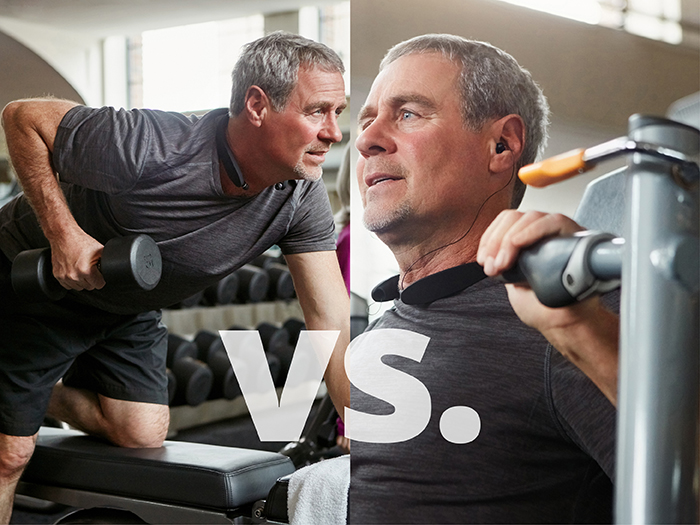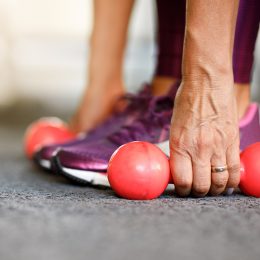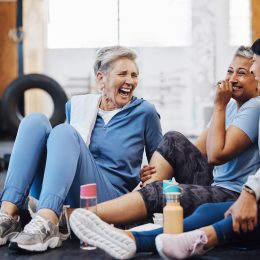Free Weights Versus Strength Machines: Which Is Best?
Both have unique advantages for your unique body—and your unique fitness goals.

Exercisers have strong opinions about free weights and strength machines—specifically, which they think is best. But the truth is one approach isn’t the best 100 percent of the time.
Free weights, including dumbbells and kettlebells, allow you to move freely forward and backward, side to side, and up and down, explains Wisconsin-based personal trainer Ryan Campbell.
Strength machines, however, are typically fixed to an axis, meaning your body can only move in one predetermined path.
Which you choose comes down to this fundamental difference.
Let’s take a closer look at which is best in different circumstances, so you get the best results every time.
Get and stay active with SilverSneakers! Classes and events are happening daily at participating gyms, online through SilverSneakers LIVE, and at community centers near you. Activate your free online account to get started
Round #1: Which Is Better for Beginners?
Machines are approachable, particularly for people who are new to strength training. You need to know how to set them up, but most machines include instructions on them.
“You just hop on and you go,” says Susan Niebergall, C.P.T., a personal trainer and strength coach. “It’s in most people’s ‘safety zone,’ and there’s nothing wrong with that.”
For newbies, she explains, getting in a basic workout can be as simple as choosing three machines and performing a circuit of three rounds. “That alone can help you leave the gym feeling good, more confident in yourself, and ready to take on more in future workouts,” she says.
With free weights, on the other hand, understanding form is crucial. “You need to learn good technique and how to properly brace yourself,” Niebergall says.
A great way to learn good form: Sign up for a few one-on-one sessions with a personal trainer to go over fundamental free-weight movements, including squats, lunges, presses, and pulls.
If you’re in a SilverSneakers class, your instructor will happily check your form. If you’re exercising by yourself at the gym, don’t be shy—ask one of the trainers walking around to quickly take a look at your form. At home, using your phone to video yourself exercising can be a great way to check out your form from all angles.
Winner: Strength machines
Recommended reading: Strength Training for Older Adults: The SilverSneakers Guide
Round #2: Which Is Better for Working Around an Injury?
Because machines allow you to move only in one specific path, they often target one or two muscles, letting the rest chill out. That can be good and bad.
Focusing on strengthening one certain muscle can be beneficial following injury or when addressing muscle imbalances. For instance, if you’re relearning how to properly activate your hamstrings or trying to shore up any weaknesses in them, machines will help you do that, Campbell says.
Machines are also great for letting you work around cranky hips, knees, or shoulders, Niebergall explains. You can strengthen the muscles that support them without overly stressing that joint.
The downside: When you zero in on just one or two muscles, you’re likely only developing one function of those muscles. A leg press machine, for example, strengthens your glutes so they can help you go from sitting to standing. But it won’t do much for the part of the glutes that helps you move from side to side.
Free weights, though, can adapt to your exact needs. Because there is no predetermined path with free weights, there’s more than one way to perform the move, Campbell says.
Let’s take squats as an example. Sure, there’s a difference between good and not-so-good form, but some people’s hips may do better with squats in a narrow stance or a wide stance.
For added resistance, some people may prefer the goblet squat, which requires you to hold a dumbbell vertically at your chest, with both hands on one end of the dumbbell. But if that hurts your wrists, you can hold the dumbbell horizontally at your chest, with one hand on each end of the dumbbell.
To find your most comfortable position, you can simply adjust your feet or hands. The same holds true for other free-weight exercises. They are all modifiable to fit your exact body and goals, and don’t force your unique joints to move in ways that are painful.
Winner: Free weights
Round #3: Which Provides More Total-Body Benefits?
When you’re taking the stairs, getting up from the couch, or playing on the floor with your grandkids, there’s no axis supporting you. You are moving in all three dimensions, just like with free weights. Free-weight exercises train you how to coordinate various movements at once and treat your body as one functional unit. (Learn more about functional fitness here.)
Subscribe to our newsletter
It's quick and easy. You could be one of the 13 million people who are eligible.
Already a member? Click to discover our 15,000+ participating locations.
Follow Us
“Over the long term, that is crucial for functional health, strength, and injury prevention,” Niebergall says. And since free weights get you on your feet and fighting gravity, they are also better at building bone density and strength, she adds.
However, for most people, the biggest benefit to moving multiple joints at once—and in real-life ways—is that it’s just so darn effective. “Most people are lucky if they are able to work out three to four hours per week,” Campbell says. “So, when you work out, you need to train the most musculature possible.”
Of course, you can mix and match strength machines so you’re hitting all the major muscle groups. But remember that these machines are training your muscles in isolation—you’re not coaxing your muscles to worth together in unison.
Winner: Free weights
The Bottom Line on the Great Debate
For overall strength, function, and health, free weights will give you the biggest bang for your buck.
But if you have a favorite strength machine, by all means keep it up. Just aim to mix in some free weights.
Also, if you’re new to strength training or want to focus on a given muscle, strength machines can be great tools for helping you reach your goals.
In the end, the best workout programs take advantage of both free weights and strength machines. Find your best combination with these resources:
- The Dumbbell Workout for Your Whole Body
- The Seated Gym Machine Workout
- SilverSneakers GO (free, iOS and Android)
See our sources:
Benefits of strength training for older adults: National Institute on Aging
Strength training safety overview: American Academy of Family Physicians
Check Your SilverSneakers Eligibility Instantly
SilverSneakers members can go to thousands of nationwide gyms and fitness locations, plus take SilverSneakers LIVE online classes that are designed for all fitness levels and abilities. If you have a Medicare Advantage plan, it may include SilverSneakers — at no additional cost. Check your eligibility instantly here.
Already a member? Get your SilverSneakers member ID and exclusive fitness and wellness content by activating your online account here.
Not eligible for SilverSneakers? You can still get 200+ free SilverSneakers On-Demand videos and stay in touch with us by creating your online account.




